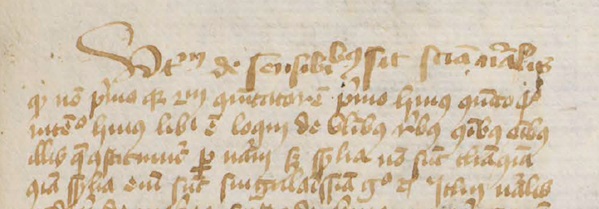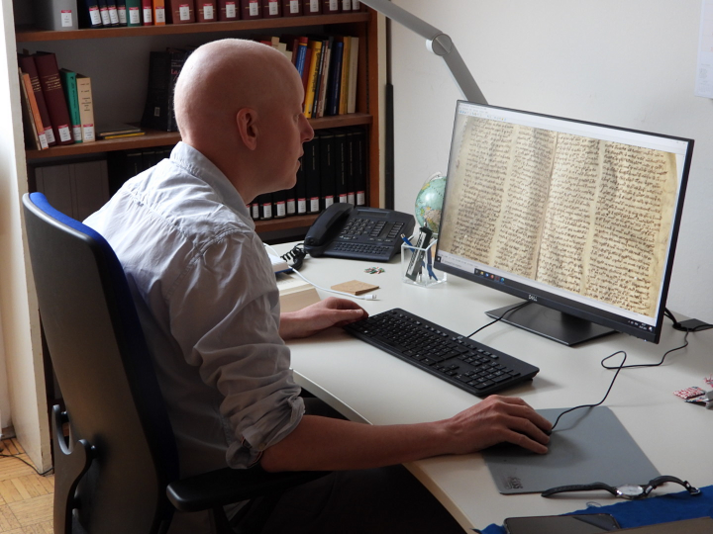Principles of the Edition
Until now Walter Burley's early commentaries on Aristotle's Physics have been hard to access for scholars of medieval philosophy. They are available only in manuscripts, and these are written in a script that is difficult to read, contain many abbreviations and lack most punctuation (see picture).

Abbreviations (recognizable through strokes or superscript letters) in these lines are for example:
Utm = utrum
sensibibus = sensibilibus
sciā= scientia
n2alis = naturalis
nō = non
pimo = primo
q2 = quia
2m = secundum
ē = est
go = ergo
To make it possible for all scholars (including those who are not trained in reading manuscripts) to read Burley's commentaries, in the text all abbreviations have been resolved, punctuation is added according to modern rules and orthography has been classicized. As a basis the orthography in R.K. Ashdowne, D.R. Howlett & R.E. Latham, Dictionary of Medieval Latin from British Sources, Oxford 2018 has been used. For example the reader will find such forms as sequuntur instead of secuntur, augmentationem instead of aumentationem, reliquum instead of relicum, definitio instead of diffinitio, verumtamen instead of verumptamen, descriptio instead of discriptio, sphaericae instead of sperice, phiala instead of fiola etc.
In the edition the lines above will look like this:
“Utrum de sensibilibus sit scientia naturalis. Quod non: primo, quia secundum Commentatorem primo huius commento quarto intentio huius libri est loqui de universalibus rebus communibus omnibus illis quae constituuntur per naturam; sed sensibilia non sunt talia communia (sensibilia enim sunt singularissima); ergo etc.”
For passages that are available in two manuscripts, the manuscripts have been compared. When they differ, the editor has chosen between the different readings. Moreover, the text of the manuscripts have been corrected wherever possible. Whenever the editor corrected the text of the manuscripts, this has been indicated. Exceptions have been made for small unquestionable corrections, like subiacet for subicet, quodam for quodem, sincategorematice for tincategorematice, or when the scribe has mistakenly written word endings above or on the line (e.g. when the manuscript has contraria instead of contraria or sole instead of sole or, the other way around, mate instead of mate [manifeste]).
Corrections, deletions and additions found in manuscript G (in the margin or in the text) are reported, with the exception of small corrections such as the erasure of single letters or the correction of non existing words (e.g. quies from ques, formis from forms, plantae from palntae, artes from arts, evasiones from evasiationes, ferrum from ferum). However, the transcription of G is based on black and white images of the manuscript, on which some corrections may not be visible.
The margin of manuscript G is filled with hands with pointing fingers (maniculae), which indicate passages of special interest to the readers, and notes to the text, like nota, vide, opinio Commentatoris, hic habes quid sit natura universalis et quid particularis, vide causam propter quam antiqui dixerunt materiam esse naturam et non formam. Such marginal notes go unreported.
To make the structure of the text clearer, divisions and headings have been added, which are based on Burley’s text (e.g. Istud capitulum continet duas partes principales. Prima continet opiniones non naturaliter loquentium. Secunda continet opiniones naturaliter loquentium). The commenta, the questions, the arguments at the beginning of the questions and their solution at the end have been numbered. A similar numbering appears in G. The editor has silently corrected its mistakes and has written the numbers of the commenta in front of the lemmata of Aristotle’s text (in the middle part of book II G writes them behind the lemmata, e.g. “Quoniam determinatum”, commentum decimum sextum).
Corrections of textual omissions written in the inner margin of manuscript G are not visible on the images of the manuscript. These will be checked in the original manuscript at a later time.
The edition gives detailed information about Burley’s sources. All references to Aristotle consist of the title of the work, the book and chapter number and the Bekker numbering. References to Averroes indicate the title of the work, the book and the section of Averroes’ commentary, followed by the folio and its section in the Editio Iuntina of 1564–1574 (repr. Frankfurt am Main 1962). Whenever newer editions are available, they will be used.
The digital Edition is written in XML-Code according to the guidelines of the Text Encoding Initiative (TEI).

